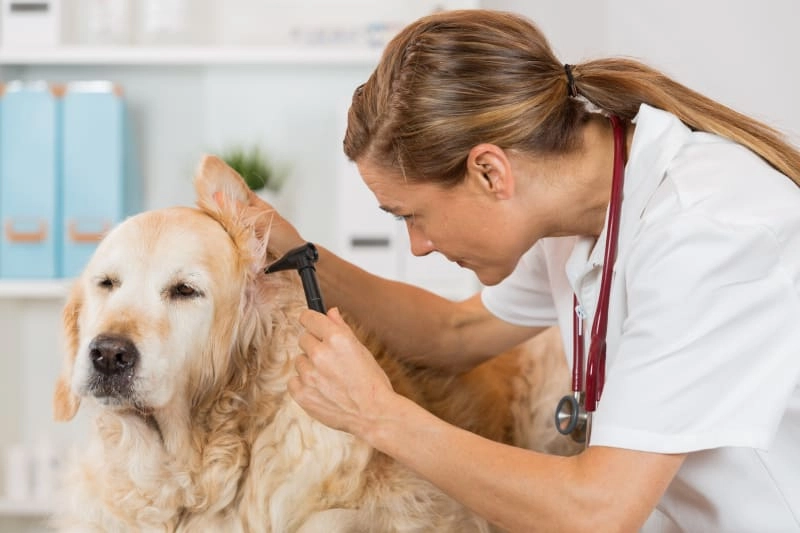For busy entrepreneurs, pet health often takes a backseat amid relentless schedules. Understanding ear infections in pets is essential for maintaining their well-being. Various factors contribute to these infections, including allergies and breed-specific traits. Recognizing symptoms and implementing preventative measures can safeguard pets from discomfort. However, knowing when to seek veterinary care can be the difference between a minor issue and a serious health concern. What are the key signs and preventive strategies every pet owner should know?
Key Takeaways
- Allergies, whether environmental or food-related, are a common cause of ear infections in pets.
- Moisture from swimming or bathing can lead to infections by creating a breeding ground for bacteria.
- Breeds with floppy ears have less airflow, increasing the likelihood of developing ear infections.
- Foreign objects, like grass seeds, can irritate the ear canal and trigger infections.
- Underlying health issues, such as hormonal imbalances, may predispose pets to ear infections.
Common Symptoms of Ear Infections in Pets
Ear infections in pets can often lead to discomfort and distress, making it essential for pet owners to recognize the symptoms early. Common signs include excessive scratching at the ears, shaking of the head, and a foul odor emanating from the ear canal. Pets may also exhibit redness or swelling around the ears and discharge that varies in color and consistency. Behavioral changes, such as irritability or withdrawal, can also indicate discomfort. Understanding what causes ear infections in pets—such as allergies, foreign bodies, or moisture accumulation—can help owners respond effectively. Recognizing these symptoms is crucial for timely veterinary intervention, which can alleviate pain and prevent more serious health issues, ensuring pets remain happy and healthy members of the family.
Factors Contributing to Ear Infections in Pets
A variety of factors can contribute to the development of ear infections in pets, making it essential for owners to be aware of these potential causes. Allergies, whether environmental or food-related, can lead to inflammation in the ears, creating an ideal environment for infection. In addition, moisture from swimming or bathing can introduce bacteria and yeast, exacerbating the risk. Certain breeds, particularly those with floppy ears, may experience poor airflow, increasing susceptibility. Foreign objects, such as grass seeds, can also irritate the ear canal. Moreover, underlying health issues, like hormonal imbalances, may predispose pets to infections. Understanding these factors is vital for proactive pet care, ensuring a healthier and happier life for beloved companions.
Types of Ear Infections in Pets
Understanding the various types of ear infections in pets is essential for effective diagnosis and treatment. Recognizing the specific type can greatly influence the management strategy.
- Otitis Externa: This infection affects the outer ear canal, often caused by allergies or moisture.
- Otitis Media: Involving the middle ear, this type can result from untreated otitis externa or upper respiratory infections, leading to more severe symptoms like pain and fever.
- Otitis Interna: This is a more serious condition affecting the inner ear, potentially causing balance issues and neurological symptoms.
Pet owners should familiarize themselves with these types to better understand what causes ear infections in pets, ensuring timely veterinary intervention and care for their beloved companions.
Preventative Measures for Ear Infections in Pets
While many pet owners may not realize the importance of regular ear care, implementing preventative measures can greatly reduce the risk of infections. Routine ear cleaning is important, as it helps remove dirt, wax, and moisture that can lead to bacterial growth. Using a vet-recommended ear cleaner, pet owners should gently clean their pets’ ears once a month. Additionally, keeping pets’ ears dry, especially after swimming or bathing, is essential. Regular grooming can also prevent hair from blocking the ear canal. Monitoring for signs of discomfort, such as scratching or head shaking, is necessary. By fostering these habits, pet owners not only protect their furry companions but also enhance their overall well-being, creating a stronger bond and sense of belonging.

When to Seek Veterinary Care for Ear Infections in Pets
Recognizing the signs of ear infections in pets is crucial for timely intervention, as untreated infections can lead to more serious health issues. Pet owners should be vigilant and seek veterinary care under the following circumstances:
- Persistent Scratching or Head Shaking: If a pet constantly scratches at its ears or shakes its head, it may indicate discomfort or irritation.
- Foul Odor or Discharge: Unpleasant smells or unusual discharge from the ear canal can signify an active infection that requires professional attention.
- Change in Behavior: If a pet becomes more withdrawn, irritable, or exhibits signs of pain, it may be suffering from an ear infection that needs veterinary evaluation.
Prompt action can help preserve a pet’s health and well-being, reinforcing the importance of understanding what causes ear infections in pets.
Frequently Asked Questions
Can Ear Infections in Pets Be Contagious to Other Animals?
Ear infections in pets are not contagious to other animals. They typically arise from allergies, moisture, or foreign objects, rather than infectious agents, making it essential for pet owners to maintain proper ear hygiene to prevent occurrences.
How Do I Clean My Pet’s Ears Safely?
To clean a pet’s ears safely, use a vet-approved ear cleaner and cotton balls. Gently apply the cleaner, massage the base of the ear, and wipe away debris, ensuring not to insert anything deep into the canal.
Are Certain Breeds More Prone to Ear Infections?
Certain breeds, such as Cocker Spaniels, Bulldogs, and Basset Hounds, are more prone to ear infections due to their unique ear structures and increased moisture retention. Regular ear care can help mitigate this risk effectively.
Can Diet Affect My Pet’s Ear Health?
Diet can greatly affect a pet’s ear health. Poor nutrition may lead to skin allergies, which can increase the risk of infections. A balanced diet supports overall wellness, promoting healthier ears and reducing infection likelihood.
What Home Remedies Can Help With Ear Infections in Pets?
Home remedies for ear infections in pets include apple cider vinegar diluted with water, coconut oil for soothing, and chamomile tea compresses. These methods may provide relief, but consulting a veterinarian is essential for proper diagnosis and treatment.
Conclusion
To summarize, busy entrepreneurs can enhance their pets’ well-being by understanding the causes of ear infections and recognizing the associated symptoms. By identifying contributing factors and implementing preventative measures, such as regular ear cleaning and monitoring for signs of discomfort, they can greatly reduce the risk of infections. Staying informed and proactive not only fosters a healthier environment for their furry companions but also minimizes the likelihood of unexpected veterinary expenses, ensuring peace of mind for their owners.
You May Also Like To Read:






